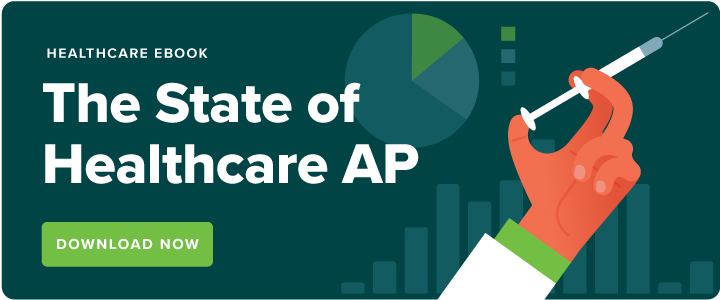Healthcare organizations have set their sights on the goal of streamlining costs, and it’s no wonder given the razor-thin margins and rising cost of care faced by many providers. According to a Deloitte survey of healthcare CFOs, cost reduction has become a leading strategic priority (83%) that increased last year, and, of course, healthcare providers need to do that without impacting patient care.
There’s really no better place to start than supplier payments, given the costs and incredible inefficiencies of processing payments manually. The good news is that there are only upsides to automating healthcare payment processes. It enables you to reduce payment costs – and potentially even get cash back; protect your organization from growing fraud risks; keep suppliers happy; and gain efficiencies that empower your team to work faster and smarter.
5 Common Misperceptions About Healthcare Payment Automation
So, what’s stopping healthcare organizations from adopting payment automation right away? Based on our experience, there are four common misperceptions that healthcare organizations have with respect to payment automation. This post aims to clear up any misunderstanding.
1. Our payment process is working well, so why should we change it?
We’re all creatures of habit, and we’re comfortable doing things the way we’ve always done it. Many accounts payable departments are used to handling payments manually through their ERP, and assume that if suppliers are getting paid, the process is working. But when you pull back the curtain, you can see problems that have always been there. First of all, it’s costly and time-consuming. According to a Visa and Barlow Research study, a whopping 97% of mid-market companies in the U.S. use checks as a B2B payment method, and every time they write one, they are losing money. It costs about $6 for organizations to issue each check, factoring in both hard and soft costs. This time-intensive process involves getting the check stock, printing checks, getting them signed, stuffing and stamping envelopes, and dropping them in the mail.
Paper-based checks, the most popular payment method for healthcare organizations, also make healthcare organizations vulnerable to fraud. In fact, it’s the number one method associated with fraud, according to the 2020 AFP Payments Fraud and Control Survey, and can have a major impact on the organization. The study reports that fraud causes organizations to lose 5% of their revenue annually on average, or collectively, more than $4.5 trillion dollars per year.
By contrast, electronic payments, especially virtual cards, provide critical protection against payment fraud. In the AFP survey, only 3% of organizations reported actual or attempted fraud with virtual cards. That’s because virtual cards have unique, randomly generated numbers that are limited to a specific payment amount and available for one-time use only.
2. Funding may be an issue. Is it costly to implement?
According to consulting firm Levvel, healthcare organizations assume that automation tools are costly to implement, but that’s far from the truth. Electronic payment methods start paying for themselves right away, in as little as one to two months, by reducing costly processes and overdue payments, and eliminating time-consuming, tedious work. In fact, you can even generate revenue when you use virtual cards, which provide cash-back rebates on all of your supplier payments. Because of this, some organizations have been able to transform payments from a cost to a profit center, giving them funds to invest in other areas of the business.
3. Will it take a lot of time? We don’t have the bandwidth right now to deal with a difficult, time-consuming implementation.
Payment automation can’t be any simpler, since the payments service provider does just about all of the work. Your role is to give the provider a list of your suppliers and work with them to determine how they will be approached, and then the provider takes it from there. From start to finish, we’re talking weeks, not months, to automate your payment process and start seeing meaningful adoption of ePayment types.
4. Will the change process be disruptive?
Because the right payment automation solution is easy to implement and can be configured to your specific needs, there is minimal disruption as you change from a manual to automated payment process. In fact, you will see that the monthly disruptions that you are used to – such as errors, and time-consuming processes – disappear, and the process will work smoother and more efficiently than ever.
5. Will our suppliers be resistant to payment automation?
The main issue that negatively impacts supplier relationships is late payments, which is all too common with manual payment because it takes a lot of time from start to finish. Additionally, time can be wasted during the manual payment authorization process if the authorizer is unavailable, or if invoices fall through the cracks. This can result in payment delays, late fees, and potentially unhappy suppliers.
With the supply chain concerns healthcare organizations recently experienced in receiving PPE and other medical supplies during COVID-19, it’s more important than ever to make sure you are paying your suppliers on time and keeping them happy.
Payment automation provides the control and oversight to ensure that payment is provided in a timely manner. Additionally, it gives you the flexibility to use different payment methods, such as checks, ACH, virtual cards, foreign exchange (FX) – that can meet supplier needs for fast payment while allowing you to benefit from enhanced security and cash-back rebates.
Also, by consistently paying suppliers on time, you might gain leverage to negotiate and extend credit limits.
Payment Automation Delivers Only Upside to Healthcare Organizations
With pressure to reduce costs and only an upside to payment automation, there’s no time like now to make the change. With barely any work on your part, or disruption, you will significantly save money, streamline processes, gain efficiencies, and improve supplier relationships.




